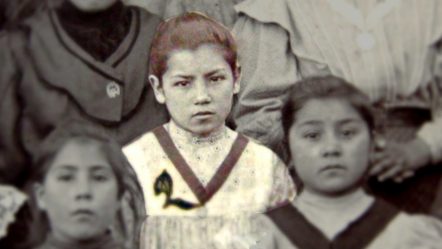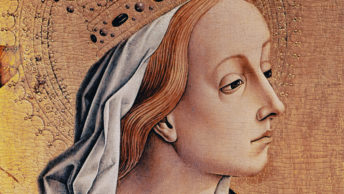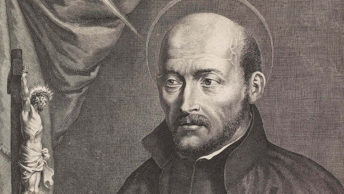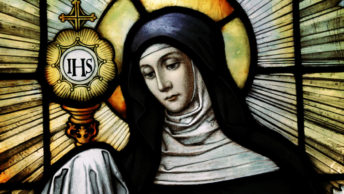On another day, in the bookish context of superstar Colombian author Gabriel García Márquez and of his writings, I might speak to you about the Chilean/Argentine near-teen, near-saint, near-martyr whose feast day we celebrate on January 22, Blessed Laura Vicuña. And, on that day, I will tell you that more than anything else his travestying of her story in the América Vicuña episode of his 1985 novel Love in the Time of Cholera bespoke his own twisted, scapegrace psycho-sexual condition, as well as too his anger with his Father/God, author of the sex-ethical system that so ticked him off. Indeed, these are truths about the guy that I have for some time been trying to get my colleagues in the literary/scholarly profession to deal with.[1]
On another day, too, I might speak to you about the child-saint in the other bookish context that is the Argentine man-of-letters, man-of-principles, and man-of-politics Domingo Faustino Sarmiento’s masterwork, Facundo: Civilization and Barbarism (1845). And, on that day I will be saying that her hagiographical record and the maximally important literary text are in accord. In both, the point is emphatically made that 19th Century Argentina’s penchant for rule by outsized, barbarian pistoleros in its local as well as in national scenes was disastrous. This thought will matter greatly to Sarmiento folk because of late no small number of academics have taken to expressing doubts about his book’s preachments in this regard.[2] But, no, says the Laura story, the Facundo author was absolutely right. As for the thought’s having value for Catholics like you and me, yes, that too will be the case. For being aware of what Sarmiento said about the perennial conflict between Barbarism and Civilization in the Argentine frontier, we will better understand what Laura was up against when she took the heroic stand against the vile approaches of the ranchero Mora that she took. Also, more historically meaningful will become for us the civilizational change that came over Junin de los Andes, Argentine, after her sacrifice.
Lastly, on yet another day, I might speak to you about Laura in the context of the writings of her familiares and/or namesakes, the journalists/politician Pedro Felix Vicuña (1805-1874) and his son Benjamin Vicuña Mackenna (1831-1886). In brief, on that day I will be telling you that, howsoever commendable and progressive the published thoughts and the recorded deeds of these gentlemen (the latter was twice imprisoned and once sentenced to death for anti-dictatorial activities), Laura and her mother’s mestiza experience of the larger, creole Vicuña family’s race and class attitudes was less than shining.
But today is Laura’s feast day, and more appropriate than these scholarly renderings of the girl’s life is my telling you her story as un-bookishly as possible, or, better said, as unadornedly and as honestly as a nun might. It is for this reason that I take as my text’s primary source today the biography of Laura written by Salesian Sister M. Domenica Grassiano—by, that is, a Sister in the very order of nuns who were the girl’s frontier educators.[3] Yes, if you want to get the Laura Vicuña story told rightly, get it from a Salesian nun such as Sister Grassiano.
The story
In 1891, in Santiago, Chile, Laura was born the first child to Joseph Dominic Vicuña and his wife, Mercedes Pino. Joseph was criollo, an army officer and a member of a distinguished family with a proud Chilean heritage. Among his familial predecessors were Pedro Felix Vicuña (1805-1874), founder of the Valparaiso newspaper, El Mercurio, and Benjamin Vicuña McKenna, the writer, statesman and politician, who was his country’s Benjamin Franklin (1831-1886), and Claudio Vicuña, soon to be nominated for the country’s presidency. Mercedes, on the other hand, came from a humble background. She was mestiza and the daughter of ordinary farming people. As a result of this social imbalance, the couple’s marriage was not blessed by the larger Vicuña family. Indeed, Joseph was disowned by the Vicuña’s, Mercedes repudiated, and their children discounted. No one save godparents attended Laura’s baptism (Grassiano 5).
Soon this familial rejection had even more dire consequences. In the year of Laura’s birth, Civil War erupted in Chile. Her father, along with the rest of the Chilean army, fought on the losing side, that of the country’s Liberal President, José Manuel Balmaceda. When the liberal cause was defeated and Balmaceda chased from office, the army scattered to rural areas. Among the refugees, were Laura and her parents, who fled 500 kilometers south to the remote Andean village, Temuco. There, a year-and-a-half later, just after the birth of a second daughter, another tragedy befell the family: Laura’s father died of pneumonia and (the biographer suggests) of hopelessness. For several years, Mercedes, the widowed mother, carried on in Temuco. She took up dressmaking, developed a business, and opened a haberdashery. However, in 1899, disaster again struck. Thieves broke into the store and cleared away everything. Laura’s mother decided to leave Temuco, to join one of the caravans of emigrants filing toward Argentina. She crossed the Andes, made a first stop at the wild frontier town of Norquin, moved on to Las Lajas, and eventually settled near Junin de los Andes, in Argentina.
In this new place, the second phase of Laura’s life began when Mercedes met “a certain Manuel Mora, a South American cowboy (gaucho) of ill repute,” says Sister Grassiano. Some years earlier, he had come from Chos-Malal (a regional capital, farther north in the territory) “where he had served prison sentences for crimes unknown.” From a life of absolute disgrace, however, he had been saved by well-off family connections in Buenos Aires. They secured for him a government permit to work lands along the folds of the Chapeloo Mountains. By the time the Vicuña’s arrived, he had two large “estancias” and was the wealthiest, most ruthless “ranchero” in the Neuquen territory. He treated indigenous workers like slaves, and used the whip on servants, horsemen and dogs alike. Also, for lengths of time that suited him, he kept a “mujer.” In “a desperate effort to get on top of misfortune,” says Sister Grassiano, Mercedes became Mora’s common-law wife, moving herself and the two children on to his Quilquihue ranch. The girls, however, did not stay long. When it became apparent to Mercedes that Mora had designs on her eldest daughter, she enrolled both girls in the recently-opened Salesian Sisters’ school in Junin de los Andes. Thus, in January of 1900, Laura and her sister Julia moved in as boarders at the College of Mary Help of Christians.
The biography’s next several chapters describe the Sisters’ fledgling missionary school and Laura’s eager adaptation to its religious program. Only a year earlier, the Sisters had arrived in this crossroads place called Junin de los Andes, where their mission was to serve the area’s growing population—indigenous peoples chased into the nearby mountains, just-arrived emigrant and immigrant families, children connected to the military outpost, the variously displaced (like the Vicuña’s)—and, too, to foster the growth of a family-based community. They would do so by running the only girls school within a radius of several hundred miles and there teaching intellectual, domestic and spiritual arts to girls “who found it easier to handle the horse’s reins than the pen and the needle” (20).
Laura came to them reading and writing a little, and capable of reciting a few prayers. Quickly, however, she became a model student in all areas of the school’s program, applying herself especially to the fulfillment of the Sisters’ recommended prayer routine. She liked to pray and to do God’s will; she was exceedingly happy to be at the College. Her single, private preoccupation was for her mother. Once, hearing one of the Sisters talk about the sacrament of marriage and of the area’s great need for a culture of family, Laura realized that her mother was in a relationship that “God would not approve of” and she fainted. At that moment, she did not tell the Sisters of her worry; instead, privately she began praying ceaselessly that her mother would leave Mora.
Thus, the situation continued until Christmas of Laura’s second year. Home for vacation at the Quilquihue ranch, she became again Mora’s target. Though he had been living with the mother, his intention was to marry the daughter. It was for this he was educating her, said the local people, for this he sent her to the Sisters’ school (31). Did Mercedes know this? It’s not clear, says Sister Grassiano, though situations like this would not have been uncommon in Neuquen at the time. Yes, all the horrific, socio-historic things that Sarmiento had said about Barbarism’s diabolical hold on his country’s pistolero-, bandito-, generalissimo-fond society in his masterwork on that topic, Facundo: Civilization and Barbarism (1845)—they were at play in the Laura Vicuña story too. She, however, by the grace of God and by way of the Sisters’ instruction, was smarter than the culture that surrounded her, as well as more determined. Wanting nothing to do with the ranchero, either as wife or concubine, she enraged him by sidestepping his every approach. Once, she ran from him and spent the night in the forest, says Sister Grassiano. On another occasion, she refused to dance with him at a drunken branding festival. For this, he threw her out into the Andean darkness. Then, he sent Mercedes out, ostensibly to persuade Laura to cooperate. Mother and daughter talked. Laura stayed outside. When Mercedes returned alone, Mora was so outraged that he tied her to a post and whipped her in full view of the festival’s crowd. They were accustomed to barbarous, anti-civilizational scenes like this, but sickened nonetheless (33).
When, next, for reasons that were slowly becoming apparent to the Sisters, Mora refused to pay the school fee, they offered to take Laura back to school without charge. Also, they allowed her to remain at the college during school recesses with those of the girls whose homes were far away. As a result, for almost two years, the situation settled into a new arrangement. Mercedes and Julia, Laura’s younger sister, remained on the ranch, while Laura lived at the college–maturing in grace, says Sister Grassiano, and praying that her mother would have the courage to leave Mora. Also, by virtue of her natural beauty and of her religious fervor, she built up a reputation for saintliness in the local area. However, this was not an arrangement that could last long. Laura’s refusal and her staying away were for Mora a local humiliation. Eventually, he would come to Junin to get the girl he considered his. When he did so, the public confrontation between the rapacious, bully ranchero and the near teen would take place. By it, the area would be changed. However, before that happened, something else occurred that would make this final encounter still more dramatic.
In June and July of 1903, the Neuquen area experienced a dark and rainy winter, whose culminating event was a week-long rainfall that swelled the waters of the Chimehuin and caused it to burst its banks. On the evening of July 16th, waters burst into the college. In the drenching storm and in rushing waters that were waist-high and higher, the children were evacuated in a cart. Terrified, the girls huddled, shivered and cried until Laura began to sing a hymn. Her companions joined in. Thus, like a miraculous raft of angels, the half-submerged, lantern-lit cart passed safely through the deadly waters, and the villagers had another stirring memory of Laura.
But the storm had negative consequences, too. Laura, who had always been frail, became frightfully sick—so sick that Mercedes took her home to Quilquihue, where she hoped to nurse her back to health. At the ranch, however, Laura again became Mora’s target, and, as a result she grew weaker. Now Mercedes was at her wit’s end. She needed to get her daughter away from Quilquihue but couldn’t return her to the Sisters because such a return would infuriate Mora. Instead, then, she rented a little two-room house in the middle of the village itself, and, there, moved with her daughter.
Now the stage was set for the public drama that would result in Junin de los Andes’ transformation. “A little, out-of-the-way settlement in the mountains,” says Sister, “is like a big family. Everyone had heard of Laura’s illness,…of Mercedes and of Mora….The name of Manuel Mora was held in horror there” (59). In December, Laura had the strength to go daily to church, but after Christmas, despite her mother’s attentions, her health failed further, and she remained more and more inside. In the little rented house, mother and daughter became constant companions, talking about what most concerned Laura, her mother’s need to break away from Mora. Then unannounced Mora arrived. He insisted on staying. Who was paying the rent? he roared. He and Mercedes argued. Though extremely weak, Laura said she would go to the school and even got outside the door. “Mora tore after her like an animal, caught her by the arm, and beating her savagely tried to get her back into the ranchito.” But a crowd had gathered, says Sister. “The villain jumped on his horse and rode away at full speed” (62).
In the days that followed, Laura’s health grew worse. Merecedes, therefore, went to the church to call in a priest. His visit initiated a steady flow of visitors to Laura’s room. All were amazed at her self-control, at her willingness to endure pain without complaint. All, too, were aware of her deathbed wish that her mother leave Mora. This wish was most memorably manifested on the afternoon of Laura’s death. In her room on that day were Mercedes, the priest, and two classmates. Laura signaled that she wished to speak to her mother. The others retired to the room’s corners. Mercedes and Laura spoke to one another; they embraced, and then Laura called over the priest. “Father, my mother has promised to leave that man” (72). A great peace had spread over her face. A few moments later, she passed away uttering prayers of thankfulness to Jesus and Mary.
News of Laura’s death spread quickly. Soon all of Junin de los Andes was filing passed her bed and bidding her farewell. Likewise, her funeral and burial drew an immense crowd, one that included Mora. On horseback, he circled the cemetery. He had come for Mercedes. The priest, however, went out to him with Mercedes’ message—that “he should not think of her anymore, because she had decided to change her way of life” (74). In the presence of so many, all Mora could do was go away. He returned, however, a few days later with revolver in hand. This time Mercedes was in the ranchito, accompanied by the two women who served in those days as her constant companions and protectors. Mora went away snarling, “You will not escape me. I will be happy only when I see you dead” (75). Mercedes made plans to flee. On a designated day, she disguised herself and walked out of town, far up the road, where she boarded a cart headed for Chile. Her escape was a Marquezian scene, at least as Sister describes it, for, when the villagers saw the hooded lady pass by, they said to themselves, “It is Mercedes Pino. She is trying to get away!” (76). Before she had gone far, however, an informant alerted Mora, who gave chase. Now the villagers conspired in knowing nothing and in sending him in the wrong direction. They had been emboldened by Laura’s example. Mercedes got away to Chile.
Lastly, the story’s aftermath: Mercedes could not return to Junin de los Andes until Mora’s rage and desire had abated. This occurred about a year-and-a-half later, when she returned for the marriage of her second daughter, Amandina, whom she had left in the care of the Sisters. Though the girl was only twelve, Mercedes responded positively to a local young man’s request to marry the girl. Years later, Amandina herself would speculate that her mother did so in order “to save me from the dangerous situation in which she had found herself with Mora” (78). Mercedes returned to Chile and died quietly on November 27th, 1929, in Cherquenco, in the Temuco valley. She was fifty-nine. Mora’s death, on the other hand, was not peaceful. At a horse racing, he lost a bet and got into a fight, punching his antagonist in the face. The other man’s step-brother entered the fray with a knife and stabbed Mora. “He died on the street covered in his own blood,” says Sister (78).
And there you have the Laura Vicuña story—on her feast day, un-bookishly told.
[1] Cussen, John, “La Beata Laura Vicuña: the Nun’s Version, corrective of García Márquez’s” Religion and the Arts 11 (2007): 373-405.
Cussen, John, “garcía márquez’s first-son/second-son, legitimate’s/ illegitimate’s intertextually Catholic anxieties,” Ravenshaw Journal of Literary and Cultural Studies 1.2 (2011): 62-81.
Cussen, John. “Essay review of Oxford Handbook of Gabriel García Márquez, eds. Gene H. Bell-Villada and Ignacio López-Calvo.” New Oxford Review (forthcoming).
[2] Fernández, Hernán. “El Facundo de Sarmiento: Problematizar La Obra Desde Sus Ediciones Póstumas.” Secuencia: Revista de Historia y Ciencias Sociales, no. 109 (January 2021): 1–29.
Fernández, Nancy. “Civilización y Barbarie, o Las Construcciones Del Imaginario Nacional: De Rosas a Urquiza.” Cuadernos de Literatura 19, no. 37 (January 2015): 275–84.
[3] Grassiano, M. Domenica. For Love of My Mother: Laura Carmen Vicuña. New Rochelle, NY: Salesiana, 1985.








